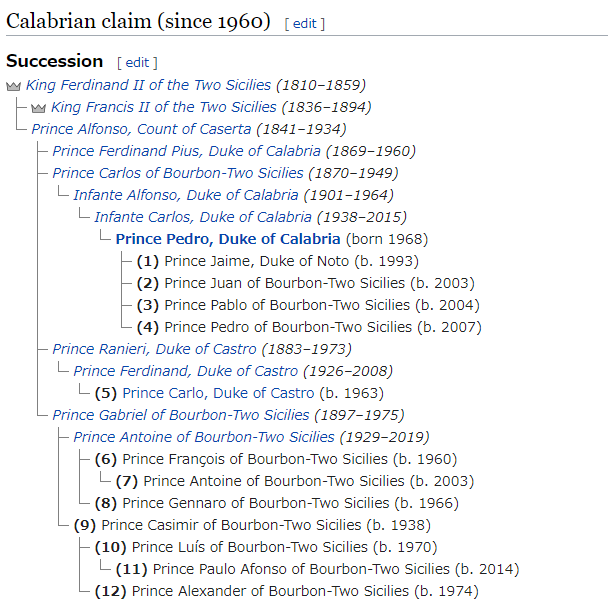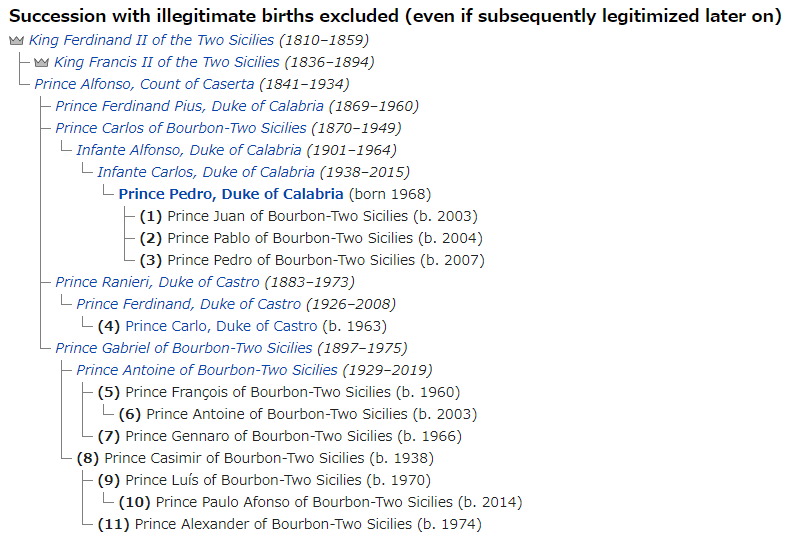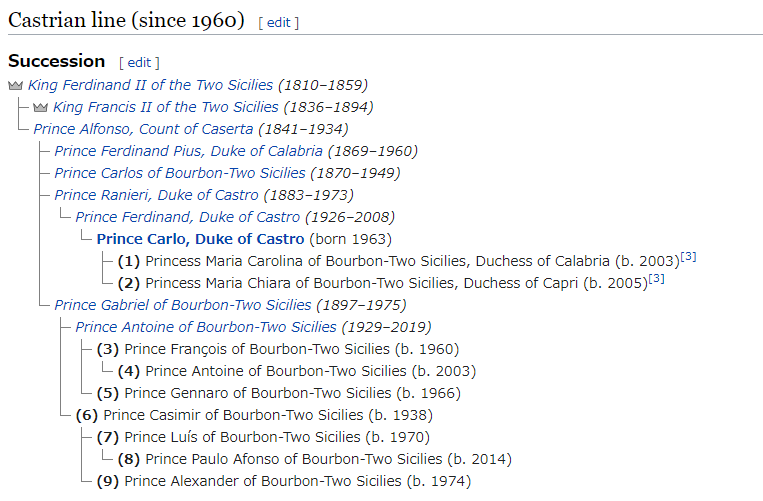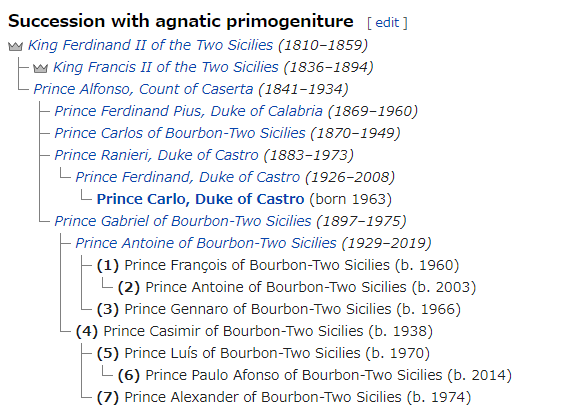note:
As of July 2020.
In Wikipedia, this article’s name was Line of succession to the former throne of the Kingdom of the Two Sicilies.
That Wikipedia’s article has deleted by Wikipedians.
See also:
Line of succession to the former Monarchical throne and others : From (deleted) Wikipedia’s articles.
The Kingdom of the Two Sicilies was unified with the Kingdom of Italy in 1860. The headship of the House of Bourbon-Two Sicilies has been disputed since the death of claimant Prince Ferdinand Pius, Duke of Calabria on 7 January 1960 between Prince Ranieri, Duke of Castro and his descendants and Infante Alfonso, Duke of Calabria and his descendants. The two current claimants to the former realm of the Two Sicilies are Prince Carlo, Duke of Castro and Prince Pedro, Duke of Calabria, both descended in the male line from Charles III of Spain, who succeeded to the crowns of Naples and Sicily in 1734, reigning there until his succession to the throne of Spain with the death of his brother, Ferdinand VI of Spain on 10 August 1759. By the treaties of Vienna of 1738 and Naples of 1759 he was obliged to surrender the thrones of Naples and Sicily to preserve the European balance of power,
The treaties of Vienna and Naples required that King Charles separate the Spanish crown from the Italian sovereignties by designating Don Charles, his second surviving son (the eldest being severely mentally handicapped), as Prince of Asturias, the heir apparent to Spain,[1] while his “Italian sovereignty” would pass immediately to his third son and his descendants in the male line, Infante Don Ferdinand, and then, in the event of the death of the latter without male heirs, to Charles’s younger sons and their descendants, by primogeniture. This new semi-Salic, succession law of the defunct Kingdom of the Two Sicilies was laid out by Charles III in the Pragmatic Decree of 6 October 1759, and established a secondogeniture similar to that governing the successions to Tuscany and Modena in the House of Austria. It further stipulated that heirs male of the body of Charles III or, failing males, the female nearest in kinship to the last male in his descent or, that lineage also failing, the heirs male of Charles III’s brothers, would inherit the Italian sovereignty (which meant the kingdoms of Naples and Sicily) but always separate from the Spanish crown and never combined in the same person.[1] Should the male line descended from Charles III’s younger sons fail, the Italian Sovereignty was always to be transferred to the next male dynast in the order of succession who was neither the monarch of Spain nor his declared heir, the Prince of Asturias.[1] Even if Infante Alfonso, Duke of Calabria, whose mother was Princess of Asturias had inherited the Spanish Crown and if he had then succeeded in 1960 as head of the Two Sicilies Royal House, the Pragmatic Decree of 1759 would have still not applied as it refers to the Italian sovereignty and was designed to preserve the balance of power, a concept that no longer existed in the twentieth century.
The succession to the Sovereignty of the Sacred Military Constantinian Order of Saint George is a separate dignity that descends to the heirs of the Farnese family and is not tied to any sovereignty; it was only held by the reigning Dukes of Parma from 1698 to 1734 and the Kings of Naples and Sicily from 1734-1860. The Apostolic Brief Sincerae Fidei and Imperial diploma of 1699 invested the grand mastership in Francesco Farnese and his family and this was confirmed in the Papal bull Militantis Ecclesiae of 1718, so when Francesco’s brother Antonio died childless in 1731 it was inherited along with Parma by Infante Don Charles of Bourbon and Farnese. When, however, he surrendered Parma to the Emperor in 1736 he retained the grand mastership and control of the Order, and his rights as Grand Master were recognised by his brother Philip who became Duke of Parma in 1748, in several decrees, as did the latter’s son, Ferdinand, Duke of Parma. On 8 March 1796 King Ferdinand IV and III of Naples and Sicily issued a decree which stated that “In his (the king’s) royal person there exists together two very distinct qualities, the one of Monarch of the Two Sicilies, and the other of Grand Master of the illustrious, royal and military Constantinian order, which though united gloriously in the same person form nonetheless at the same time two separate independent Lordships.”[2] Numerous royal and papal acts, declarations by the government of the Order, the statutes of the Order including those of 1934 which governed the succession in 1960, and expert texts written before 1960, were unanimous in confirming that the grand mastership was not united with the crown but a separate dignity, with a different system of succession (absolute Salic law, whereas the Two Sicilies was governed by semi-Salic law). Hence no act concerned only with the succession to the Two Sicilies could have any bearing on the succession to the Constantinian grand mastership, an ecclesiastical office governed by canon law.
Original claim (1861–1960)
- King Francis I of the Two Sicilies (1777–1830)
- King Ferdinand II of the Two Sicilies (1810–1859)
- King Francis II of the Two Sicilies (born 1836)
- (1) Prince Louis, Count of Trani (b. 1838)
- (2) Prince Alfonso, Count of Caserta (b. 1841)
- (3) Prince Gaetan, Count of Girgenti (b. 1846)
- (4) Prince Pasquale, Count of Bari (b. 1852)
- (5) Prince Januarius, Count of Caltagirone (b. 1857)
- Charles Ferdinand, Prince of Capua (b. 1811) (renounced succession rights after morganatic marriage)
- (6) Prince Louis, Count of Aquila (b. 1824)
- (7) Prince Luigi, Count of Roccaguglielma (b. 1845)
- (8) Prince Filippo of Bourbon-Two Sicilies (b. 1847)
- (9) Prince Francis, Count of Trapani (b. 1827)
- (10) Prince Leopoldo of the Two Sicilies (b. 1853)
Calabrian claim (since 1960)
Succession
- King Ferdinand II of the Two Sicilies (1810–1859)
- King Francis II of the Two Sicilies (1836–1894)
- Prince Alfonso, Count of Caserta (1841–1934)
- Prince Ferdinand Pius, Duke of Calabria (1869–1960)
- Prince Carlos of Bourbon-Two Sicilies (1870–1949)
- Infante Alfonso, Duke of Calabria (1901–1964)
- Infante Carlos, Duke of Calabria (1938–2015)
- Prince Pedro, Duke of Calabria (born 1968)
- (1) Prince Jaime, Duke of Noto (b. 1993)
- (2) Prince Juan of Bourbon-Two Sicilies (b. 2003)
- (3) Prince Pablo of Bourbon-Two Sicilies (b. 2004)
- (4) Prince Pedro of Bourbon-Two Sicilies (b. 2007)
- Prince Ranieri, Duke of Castro (1883–1973)
- Prince Ferdinand, Duke of Castro (1926–2008)
- (5) Prince Carlo, Duke of Castro (b. 1963)
- Prince Gabriel of Bourbon-Two Sicilies (1897–1975)
- Prince Antoine of Bourbon-Two Sicilies (1929–2019)
- (6) Prince François of Bourbon-Two Sicilies (b. 1960)
- (7) Prince Antoine of Bourbon-Two Sicilies (b. 2003)
- (8) Prince Gennaro of Bourbon-Two Sicilies (b. 1966)
- (9) Prince Casimir of Bourbon-Two Sicilies (b. 1938)
- (10) Prince Luís of Bourbon-Two Sicilies (b. 1970)
- (11) Prince Paulo Afonso of Bourbon-Two Sicilies (b. 2014)
- (12) Prince Alexander of Bourbon-Two Sicilies (b. 1974)

Succession with illegitimate births excluded (even if subsequently legitimized later on)
- King Ferdinand II of the Two Sicilies (1810–1859)
- King Francis II of the Two Sicilies (1836–1894)
- Prince Alfonso, Count of Caserta (1841–1934)
- Prince Ferdinand Pius, Duke of Calabria (1869–1960)
- Prince Carlos of Bourbon-Two Sicilies (1870–1949)
- Infante Alfonso, Duke of Calabria (1901–1964)
- Infante Carlos, Duke of Calabria (1938–2015)
- Prince Pedro, Duke of Calabria (born 1968)
- (1) Prince Juan of Bourbon-Two Sicilies (b. 2003)
- (2) Prince Pablo of Bourbon-Two Sicilies (b. 2004)
- (3) Prince Pedro of Bourbon-Two Sicilies (b. 2007)
- Prince Ranieri, Duke of Castro (1883–1973)
- Prince Ferdinand, Duke of Castro (1926–2008)
- (4) Prince Carlo, Duke of Castro (b. 1963)
- Prince Gabriel of Bourbon-Two Sicilies (1897–1975)
- Prince Antoine of Bourbon-Two Sicilies (1929–2019)
- (5) Prince François of Bourbon-Two Sicilies (b. 1960)
- (6) Prince Antoine of Bourbon-Two Sicilies (b. 2003)
- (7) Prince Gennaro of Bourbon-Two Sicilies (b. 1966)
- (8) Prince Casimir of Bourbon-Two Sicilies (b. 1938)
- (9) Prince Luís of Bourbon-Two Sicilies (b. 1970)
- (10) Prince Paulo Afonso of Bourbon-Two Sicilies (b. 2014)
- (11) Prince Alexander of Bourbon-Two Sicilies (b. 1974)

Castrian line (since 1960)
Succession
- King Ferdinand II of the Two Sicilies (1810–1859)
- King Francis II of the Two Sicilies (1836–1894)
- Prince Alfonso, Count of Caserta (1841–1934)
- Prince Ferdinand Pius, Duke of Calabria (1869–1960)
- Prince Carlos of Bourbon-Two Sicilies (1870–1949)
- Prince Ranieri, Duke of Castro (1883–1973)
- Prince Ferdinand, Duke of Castro (1926–2008)
- Prince Carlo, Duke of Castro (born 1963)
- (1) Princess Maria Carolina of Bourbon-Two Sicilies, Duchess of Calabria (b. 2003)[3]
- (2) Princess Maria Chiara of Bourbon-Two Sicilies, Duchess of Capri (b. 2005)[3]
- Prince Gabriel of Bourbon-Two Sicilies (1897–1975)
- Prince Antoine of Bourbon-Two Sicilies (1929–2019)
- (3) Prince François of Bourbon-Two Sicilies (b. 1960)
- (4) Prince Antoine of Bourbon-Two Sicilies (b. 2003)
- (5) Prince Gennaro of Bourbon-Two Sicilies (b. 1966)
- (6) Prince Casimir of Bourbon-Two Sicilies (b. 1938)
- (7) Prince Luís of Bourbon-Two Sicilies (b. 1970)
- (8) Prince Paulo Afonso of Bourbon-Two Sicilies (b. 2014)
- (9) Prince Alexander of Bourbon-Two Sicilies (b. 1974)

Succession with agnatic primogeniture
- King Ferdinand II of the Two Sicilies (1810–1859)
- King Francis II of the Two Sicilies (1836–1894)
- Prince Alfonso, Count of Caserta (1841–1934)
- Prince Ferdinand Pius, Duke of Calabria (1869–1960)
- Prince Carlos of Bourbon-Two Sicilies (1870–1949)
- Prince Ranieri, Duke of Castro (1883–1973)
- Prince Ferdinand, Duke of Castro (1926–2008)
- Prince Carlo, Duke of Castro (born 1963)
- Prince Gabriel of Bourbon-Two Sicilies (1897–1975)
- Prince Antoine of Bourbon-Two Sicilies (1929–2019)
- (1) Prince François of Bourbon-Two Sicilies (b. 1960)
- (2) Prince Antoine of Bourbon-Two Sicilies (b. 2003)
- (3) Prince Gennaro of Bourbon-Two Sicilies (b. 1966)
- (4) Prince Casimir of Bourbon-Two Sicilies (b. 1938)
- (5) Prince Luís of Bourbon-Two Sicilies (b. 1970)
- (6) Prince Paulo Afonso of Bourbon-Two Sicilies (b. 2014)
- (7) Prince Alexander of Bourbon-Two Sicilies (b. 1974)

Attempted reconciliation and continuing dispute (2014–present)
On 25 January 2014, representatives of the two rival branches, Prince Carlo (Castro line) and Prince Pedro, then Duke of Noto (Calabria line), jointly signed a solemn pledge of partial reconciliation in a ceremony in Naples on the occasion of the Beatification of Maria Cristina of Savoy, Queen of the Two Sicilies.[4] The document recognised both branches as members of the same house and royal princes and princesses of Bourbon-Two Sicilies, committed both to pursue further reconciliation and concord, meanwhile recognising the titles then claimed by each branch for the present holders and their descendants.[5]
At the Holy Mass in Saint Peter’s Basilica celebrated in Rome on 14 May 2016, during the International Pilgrimage of the Franco-Neapolitan Constantinian Order of Saint George to Rome and Vatican City, Prince Carlo made public his decision to change the rules of succession. This purported change was made in order to make the rules of succession compatible with international and European law, prohibiting any discrimination between men and women, although this law has never applied to royal successions (and has not been applied by any former reigning house, nor by the Spanish or Liechtenstein reigning houses). He declared that the rule of absolute primogeniture would henceforth apply to his direct descendants, his elder daughter being declared heiress apparent.[3] Prince Pedro publicly protested that Prince Carlo’s declaration not only violated the terms of their reconciliation agreement but that he had no powers to alter the system of succession which was governed by two international treaties as well as by the Pragmatic Decree of Charles III and the last valid Constitution of the Kingdom of the Two Sicilies. Prince Carlo’s response was that further “destabilisation” could lead to termination of the 2014 pact.[6]
In September 2017 Prince Carlo announced his second daughter Princess Maria Chiara, recognised as Duchess of Capri in the reconciliation document, would henceforth hold the additional title of Duchess of Noto.[7] In the reconciliation agreement the respective titles used by each branch were recognised and at the time the Noto title was used by Prince Pedro and following the death of his father by his son Prince Jaime.



